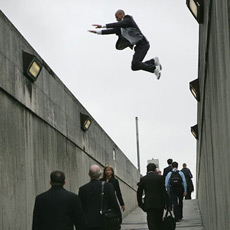Embodied Tactics of Social Space

Presented at Harvard University's Objects of Knowledge, Objects of Exchange: Contours of (Inter)disciplinarity Graduate Student Conference 2009
Abstract
Parkour is a movement practice born in the suburbs of Paris, France. Founded by David Belle and friends in Lisses during the years 1995-1997, parkour focuses on practicing efficient movements to develop one's body and mind to overcome obstacles in a mode of crisis response and subsequent escape. From its immigrant origins in the Parisian suburbs, parkour is now widely practiced outside of France. Parkour's global movement suggests the rapid and profuse dissemination of an embodied philosophy engaged in the active recovery of cultural memories, urban topographies, and social space.
Parkour: Embodied Tactics of Social Space focuses on the traceur (the parkour practitioner) as a sensorimotor organism operating within what Henri Bergson calls the "aggregate of images," providing conceptual reciprocity between mind and body, city and culture, space and time. The parkour body is traced through Bergson's "zone of indetermination" as a perceptual phenomenon and as a politicized subject within the urban landscape. I isolate parkour as a distinct historical mutation originating from the Situationist practice of the dérive (or drift) - a movement praxis antecedent to parkour's emergence in the suburbs of France over 20 years later. I trace the urban space encompassed by the dérive, and in doing so transit the parkour body to the locus of a political body. My intent, and the conceptual passement (in parkour, the vault, to jump or leap) of my paper is to synthesize Bergson's perceptual basis for the zone of indetermination with Agamben's political philosophy established by homo sacer, or sacred man, which he situates within his own "zone of irreducible indistinction."
The parkour movement presents a challenge to spatial and ideological conditioning by vaulting itself over the walls designed to contain, control, and exploit its curious nature. Parkour prefers action over words, body over technology, situation over architecture, and practice over theory. In my paper, the necessary contradiction of an intellectual exegesis of parkour is juxtaposed with the action itself. The ephemeral cultural material in consideration – digital video clips, photographs, and online excerpts of interviews with its primary practitioners – serve to highlight the problematic of an embodied theory of the traceur.
The complete paper in PDF format is located here
